Our wine guru Gary Chevsky visited the annual Gambero Rosso “Tre Bicchieri” event in San Francisco, back in February:
“On Feb 24, one of my favorite trade tasting events of the year arrived to San Francisco. For background on Gambero Rosso and their Tre Bicchieri event, see my coverage of the last year’s event. The world of Italian wine is diverse and complicated. And wonderful. Tre Bicchieri really gives you a chance to sample across the whole of Italy, and to celebrate the variety and the quality all in one place. So without further ado, I will jump straight into my impressions:
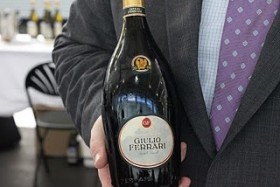
1. The biggest thing that strikes you at an event like this is just how there is always a great new unfamiliar type of wine showing up. This year, I have to give it to Sparkling. The taste and quality of the Italian sparklers is astounding. And I am not talking about Prosecco (which usually leaves me cold). I am talking about Franciacorta DOCG (in the north of Italy, in Lombardy region) and Trento DOC (in the north of Italy, in Trentino – Alto Adige region). These are serious wines made in the traditional method of Champagne. Price is a big problem for these relatively obscure (in the US) appellations, and one more reason why you don’t see a lot of them in this country. Are you willing to shell out $40-100 on an Italian sparker? (After having tasted them, I am!) Here are two of my faves:
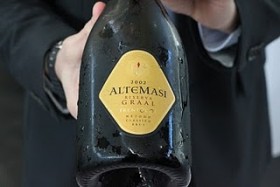 - “Trento Altemasi Graal Brut Riserva 2002” by Cavit – great nose, rich and lush apple syrup;
- “Trento Altemasi Graal Brut Riserva 2002” by Cavit – great nose, rich and lush apple syrup;
- “Trento Giulio Ferrari Riserva del Fondatore Brut 2000” by Ferrari – yeasty, bready, drier and more refined than Altemasi.
I noted them last year as well, but at that time Ca’del Bosco Franciacorta (absent this year) stole my heart.
2. A strong showing for young Amarones this year. Complexity & freshness, rather than an often-seen raisiny fruit. Amarone della Valpolicella Classico Campolongo di Torbe 2004 by Masi (still a year till official release) was ripe, juicy, meaty, spicy and fresh. An honorable mention goes to Guerrieri Rizzardi’s Amarone della Valpolicella Classico Villa Rizzardi 2005 – sweet, slightly herbaceous nose, bitter sweet on the palate.
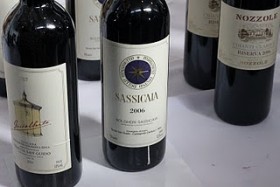 3. I must say the event seemed “poorer” this year, as most of the cult names were not there. I did see Sassicaia. That’s about it. The food was just cheese, crackers, and fruit. Nor did I see the Tre Bicchieri guides or even cork-screws given away like I’d spotted a year ago.
3. I must say the event seemed “poorer” this year, as most of the cult names were not there. I did see Sassicaia. That’s about it. The food was just cheese, crackers, and fruit. Nor did I see the Tre Bicchieri guides or even cork-screws given away like I’d spotted a year ago.
4. Relatively thin showing by Barolo and Brunello reminded me that there are fewer celebrated wines in the most recent release (2005) than a year ago (2004). Only one Brunello stood out for me – Canalicchio di Sopra 2004 – young, fresh and tasty! There were some excellent examples of 2005 Barolo. The charming and talented Giuseppe Vaira delivered on his Barolo Bricco delle Viole 2005 – sweet, soft-textured, intensely flavored, plum, tea, with loads of dark berries. Vietti’s Barolo Lazzarito 2005 was a classic – a powerhouse Nebbiolo, full-flavored, jerky, tannin, serious, young, deep, concentrated black cherry. Several other wines were solid though not amazing – Oddero Barolo Mondoca di Bussia Soprana 2004 (blueberry/cherry tea), Elvio Cogno Barolo V. Elena 2004 (soft and charming), Bezza & Figli Barolo Sarmassa 2005 (toothpasty fresh tea), Travaglini Gattinara Riserva 2004 (meaty and gritty), Prunotto Barolo Bussia 2005 (light & tart), and finally Pio Cesare Barolo Ornato 2005 (herb, spice and blackberry with a unique personality). So long as we are on the subject of Nebbiolo, a notable mention should also go to Ca’del Baio’s Barbaresco Asili 2006 – sweet and tart, slightly spicy, intense and substantive, tannic, with a touch of coffee, poured by the friendly winemaker sisters – Paola and Valentina Grasso.
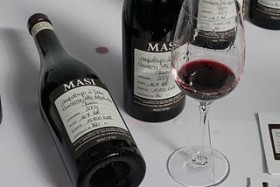 5. Bordeaux varietals and super-tuscans (or Toscana) were all the rage. A lot of good quality Cabs, Merlots, and Bordeaux blends some enhanced with Sangiovese, reminiscent of Bordeaux but with zingier acidity that I so love in Italian wine. The 2006 Bolgheri Sassicaia by Tenuta San Guido was expectedly outstanding (97pts Antonio Galloni, $150 retail) – dusty plum, nice tannins, a slight green component that added to the complexity, very good! The first vintage (2006) of Coevo by Cecchi was excellent too – flavor taking me to the right-bank of Bordeaux, great balance and complexity, 50% Sangio / 10% Cab / 20% Merlot / 20% Petit Verdot, dry blackberries, jerky. Galatrona 2007 (98pts Wine Spectator) from Petrolo, made from 100% Merlot, was a powerhouse gorgeous beast of a wine – veggie and spice, fresh, super-concentrated thick dark berry fruit. If Sassicaia were Pierce Brosnan, the Galatrona was Arnold Schwarzenegger.
5. Bordeaux varietals and super-tuscans (or Toscana) were all the rage. A lot of good quality Cabs, Merlots, and Bordeaux blends some enhanced with Sangiovese, reminiscent of Bordeaux but with zingier acidity that I so love in Italian wine. The 2006 Bolgheri Sassicaia by Tenuta San Guido was expectedly outstanding (97pts Antonio Galloni, $150 retail) – dusty plum, nice tannins, a slight green component that added to the complexity, very good! The first vintage (2006) of Coevo by Cecchi was excellent too – flavor taking me to the right-bank of Bordeaux, great balance and complexity, 50% Sangio / 10% Cab / 20% Merlot / 20% Petit Verdot, dry blackberries, jerky. Galatrona 2007 (98pts Wine Spectator) from Petrolo, made from 100% Merlot, was a powerhouse gorgeous beast of a wine – veggie and spice, fresh, super-concentrated thick dark berry fruit. If Sassicaia were Pierce Brosnan, the Galatrona was Arnold Schwarzenegger.
6. Tre Bicchieri wines (at least all the ones I was drawn to taste) are expensive. Definitely if you want the good stuff, brace yourself — you will pay just as much as for high-end French. I don’t see any obvious “value” categories at the Tre Bicchieri level.
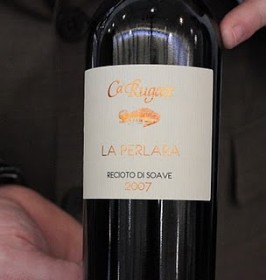 7. Recioto di Soave was a revelation. La Perlara 2007 by Ca’Rugate – a sweet wine of considerable complexity was perhaps the 2nd best Italian sweet white I’d ever had, bested only by the Vin Santo di Montepulciano Avignonesi 1996 from last year’s event. Being more familiar with Recioto di Valpolicella (a sweet red wine), I learned that “recioto” style of winemaking (where grapes are dried on mats for months, vinified somewhere along the way to raisinhood) is also applied to white wine made in Soave from the Garganega grape (in Veneto, in the northeast of Italy, neighboring with Valpolicella).
7. Recioto di Soave was a revelation. La Perlara 2007 by Ca’Rugate – a sweet wine of considerable complexity was perhaps the 2nd best Italian sweet white I’d ever had, bested only by the Vin Santo di Montepulciano Avignonesi 1996 from last year’s event. Being more familiar with Recioto di Valpolicella (a sweet red wine), I learned that “recioto” style of winemaking (where grapes are dried on mats for months, vinified somewhere along the way to raisinhood) is also applied to white wine made in Soave from the Garganega grape (in Veneto, in the northeast of Italy, neighboring with Valpolicella).
8. Some outstanding wines are not imported to California (or the US altogether). The Recioto di Soave above was one of them. Several more that stood out for me were:
a) Franciacorta Saten 2006 sparkler by Il Mosnel - 100% chardonnay, fresh rich lemon custard;
b) Barbera d’Asti Superiore Nizza 2006 by Tenuta Olim Bauda – rich, fresh, balanced, a fairly substantial Barbera; 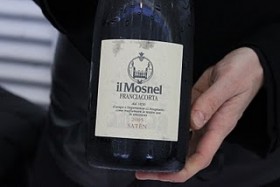
c) Chianti Classico Riserva 2006 by Tenuta di Capraia – good balance, fruit, great acid, nice soft texture/tannin.
After 5 tooth-staining hours of pacing myself through the aisles, I was exhausted. The wines I commented on here, I re-tasted 2-3 times throughout the evening, doing my part in delivering diligent assessment to you, my readers. I know, I know – it’s a tough job, but someone’s gotta do it!”
Tags: Amarone, Barolo, Brunello, Ca'del Bosco, Cavit, Ferrari, Franciacorta, Gambero Rosso, Il Mosnel, Masi, Sassicaia, Tenuta di Capraia, Tenuta Olim Bauda, Tre Bicchieri, Trento DOC, Valpolicella
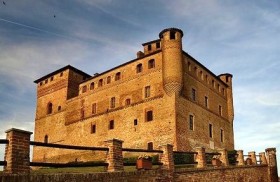 The castle is an imposing building erected around a central tower that dates back to the 1st half of the 11th century and post a restoration in 1960 it can be admired in all of its original beauty. Moreover, by being set off from the town and surrounded by vineyards on three sides, it has one of the most spectacular settings in the Langhe.
The castle is an imposing building erected around a central tower that dates back to the 1st half of the 11th century and post a restoration in 1960 it can be admired in all of its original beauty. Moreover, by being set off from the town and surrounded by vineyards on three sides, it has one of the most spectacular settings in the Langhe.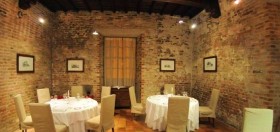 When my wine fanatic friends are visiting me at TorreBarolo, I always bring them here as from my experience it does have the best selection of the regional offerings and offering good one stop shopping. Here you can find a list of all the wineries represented in the Enoteca Regionale. On the 1st floor is the Hall of the Masks as well as a restaurant and bar. The Hall of the Masks is where the Order of the Knights of the Truffle and Wines of Alba as well as the National Association of Cheese tasters celebrates its Chapters. The Restaurant Al Castello offers a unique setting; however, it is the bar that I think is worth making a special stop for as it has a huge window that frames the surrounding vineyards that makes for a breath-taking venue to have a café or aperitif.
When my wine fanatic friends are visiting me at TorreBarolo, I always bring them here as from my experience it does have the best selection of the regional offerings and offering good one stop shopping. Here you can find a list of all the wineries represented in the Enoteca Regionale. On the 1st floor is the Hall of the Masks as well as a restaurant and bar. The Hall of the Masks is where the Order of the Knights of the Truffle and Wines of Alba as well as the National Association of Cheese tasters celebrates its Chapters. The Restaurant Al Castello offers a unique setting; however, it is the bar that I think is worth making a special stop for as it has a huge window that frames the surrounding vineyards that makes for a breath-taking venue to have a café or aperitif.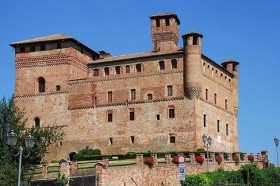 Several of the castle’s rooms are dedicated to ethnography and the castle houses a permanent museum which includes truffles, rare articles relating to local food and wine traditions as well as kitchen setting from the 17th century.
Several of the castle’s rooms are dedicated to ethnography and the castle houses a permanent museum which includes truffles, rare articles relating to local food and wine traditions as well as kitchen setting from the 17th century.





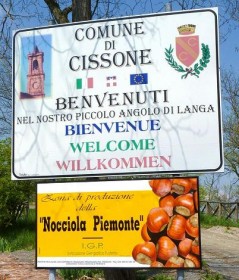
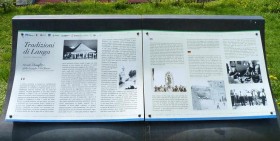
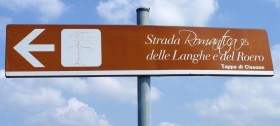
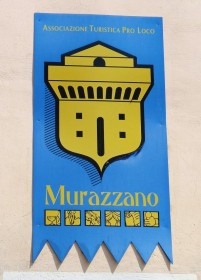
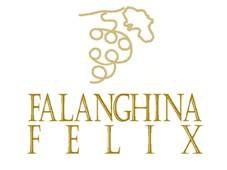 Our friend
Our friend 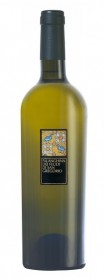
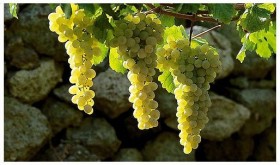 It seems that every region in Italy has its staple red and white wine. For those next to water, you can be sure, the wine is going to scream seafood. No oak, great acidity, balanced fruit and mineral. These wines don’t tend to be great, but for $10-15, they are perfect with crab, shrimp, lobster salads, ceviches, and all kinds of honest-to-goodness fresh seafood cornucopia that we so enjoy here on the Pacific coast! This particular bottle of the 2008 Falanghina from one of the top Campania houses –
It seems that every region in Italy has its staple red and white wine. For those next to water, you can be sure, the wine is going to scream seafood. No oak, great acidity, balanced fruit and mineral. These wines don’t tend to be great, but for $10-15, they are perfect with crab, shrimp, lobster salads, ceviches, and all kinds of honest-to-goodness fresh seafood cornucopia that we so enjoy here on the Pacific coast! This particular bottle of the 2008 Falanghina from one of the top Campania houses – 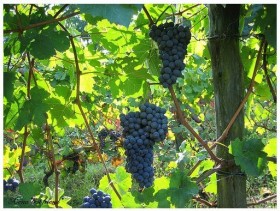
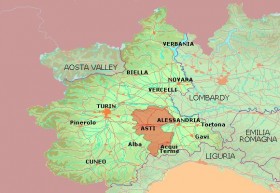 Like so many Italian red wines, except its powerhouse big brothers Barbaresco and Barolo, a Barbera has that tart, light, berry-like flavor and a texture that seems a little grainy and rough, as if a few seeds of a fresh raspberry had found their way into the bottle and added their own little interesting zip there.
Like so many Italian red wines, except its powerhouse big brothers Barbaresco and Barolo, a Barbera has that tart, light, berry-like flavor and a texture that seems a little grainy and rough, as if a few seeds of a fresh raspberry had found their way into the bottle and added their own little interesting zip there. 









